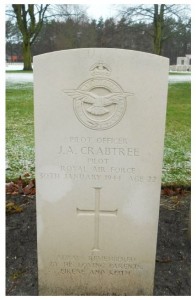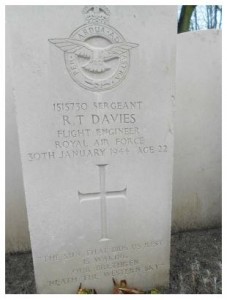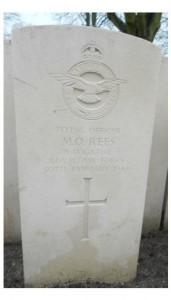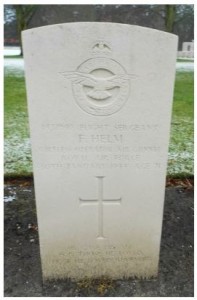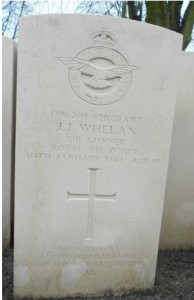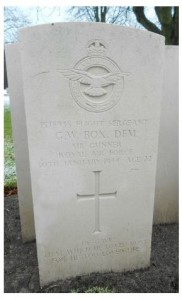This page is dedicated in honour of John Athelstan Crabtree
P/O John Athelstan Crabtree
Many thanks to Keith Crabtree for telling me about his elder brother P/O John Athelstan Crabtree – known in close family circles as ‘Athel’.
Athel was born in O/N/D 1921 to Harold George Athelstan Crabtree and Edith at 17 Queens Road, Linthorpe, Middlesbrough. There were three children Eirene, the eldest, Athel a couple of years her junior and Keith, ten years younger than his brother.
So it was quite natural that he would volunteer for the RAF when called-up.
AC2 John A Crabtree was posted to 7 Initial Training Wing, RAF Newquay, Cornwall. Here he was given over to the tender mercies of an NCO for ‘square-bashing’ and to instructors for the theoretical studies of such topics as airmanship, armaments, aero-engines, astronomy, aircraft recognition, hygiene, instruments, map-reading, meteorology, photography, signals and RAF law.
Near the end of the six week course came a series of tests and examinations. An interview would establish, even at this early stage, whether the AC2 (aircraftsman second class) exhibited the qualities necessary to later become an officer -‘initiative, capacity for leadership, willingness to accept responsibility and the ability to criticise constructively any aspect of the work at his unit.’ (‘Britain’s Wonderful Air Force’ circa 1943). This assessment was apparently attached to his record for consideration later in his training.
Keith recalls a snatch of a song from his brother’s early training days – ‘We are the boys of Clyffe Pypard ………….didn’t come here to do drill hours, we came here to get up and fly’ or lyrics to that effect. RAF Clyffe Pypard near Brize Norton, Wiltshire was the home of 29 EFTS (Elementary Flying Training School) where budding pilots were assessed for an aptitude for flying, accompanying an instructor in single-engine Tiger Moth bi-planes.
Pilot cadets did not necessarily ‘go solo’ at EFTS but the process of covering the ‘basics’ of taking-off into the wind, gliding approach and landing and spinning served to expose any significant aversion to flying and so avoided sending a clearly unsuitable candidate abroad for flying training proper.
LAC Crabtree crossed the Atlantic for the next stage in his pilot training – not at the ‘Arnold Scheme’ schools of Florida, Georgia and Alabama but Athel was to train at a BFTS school.
British Flying Training Schools were set up in America under contract to the RAF as part of the overall ‘Lend Lease’ arrangement at civilian aerodromes with predominantly US civilian staff and aircraft supplied by the USAAC
(later USAAF) under RAF command.
There were initially six BFTSs:-
1 BFTS Terrell, Texas
2 BFTS Lancaster, California,
3 BFTS Miami. Oklahoma,
4 BFTS Mesa, Arizona,
5 BFTS Clewiston, Florida,
6 BFTS Ponca City, Oklahoma,
7 BFTS Sweetwater, Texas existed briefly between May and August 1942.
The BFTS differed from USAAC training schools in that primary, basic and advanced courses were staged at one school where pilots u/t (if they stayed the course) would be based for a six month period as opposed to three separate two month postings. Pilot cadets in USAAC schools were effectively training as US Officer cadets. The six month posting allowed trainees a settled training environment and opportunities to enjoy local hospitality to build friendships. John A Crabtree completed his flying training at Terrell and was awarded his wings.
By the end of his six month posting Athel had became engaged to Louise Quinn, a Terrell girl and intended to return to live in USA.
Returning to the UK, Sgt Crabtree (pilot) continued his development towards operational status, having completed conversion training he and his crew were posted to 100 Squadron at RAF Waltham for operational flying duties.
Athel’s crew:-
F/E Sgt R T Davies
Nav F/O M O Rees
B/A Sgt J W Knight
W/op a/g Sgt F Helm
M/U Sgt J J Whelan
R/G Sgt T S Sanders
On 3rd November 1943 Sgt J A Crabtree flew his first operation as ‘second dickie’ with Canadian pilot F/Sgt Gerald Henderson in ED815 HW-G against Dusseldorf. Other new pilots to the squadron having their first experience of operations were F/Sgt Doughty, F/Sgt Bouchard, F/O Jones, and F/Sgt Oliver.
22nd Nov ED536 HW-W Berlin
3rd Dec JB563 HW-G Leipzig – up 00.18 dn 07.29 ‘Primary 04.09hrs, 21,000ft. Bombed centre of green TIs. On return found an unexpected SW wind and crossed French coast off track.’
16th Dec DV176 HW-B Berlin – up 16.25 dn 23.55 ‘Primary 20.08hrs 20,000ft, Glow on clouds as aircraft left target area. A good trip except for conditions at Base on return.’ This was, of course, a reference to the appalling weather conditions of fog and low cloud experienced by Lincolnshire based crews on their return from Berlin on ‘Black Thursday’. As noted in the ORB ‘there was no diversion area’. 100 Squadron lost four crews to crashes – F/Sgt Kevis and Sgt Denman’s aircraft collided practically over Base when both broke cloud. W/C David Holford DSO DFC, 100 Squadron CO crashed on approach to RAF Kelstern’s runway and F/O Proudfoot crashed 4 miles from Base.
20th Dec DV176 HW-B Frankfurt (now F/Sgt) up 16.56 dn 22.34 ‘Primary 19.43½hrs, 20,000ft. Marking of target very weak. Fires mostly incendiaries taking hold.’ Rear gunner for this sortie Sgt Warren.
23rd Dec JB603 HW-E Berlin – up 23.30 dn 07.39 ‘Primary 04.07hrs, 21,000ft. Bombed green TIs seen to cascade and burning on ground. Big explosion just east of main concentration of bombing.’
On 5th/6th January squadron C/O W/C John Dilworth flew ND398 manned by the Crabtree crew.
W/O Neal’s regular rear gunner had been injured during the operation against Berlin on 1st January 1944.
On the Brunswick op on 14th Jan W/O Neal’s Lancaster again suffered an attack in which the rear gunner was mortally wounded. ORB records:- ‘Primary 19.20 hrs 20,000feet. Rear gunner killed in combat with JU88 15 miles south of BRUNSWICK. Lanc extensively damaged and crash landed at base. Attack well concentrated.’
Sgt Thomas Stephen Sanders was a ‘spare bod’ borrowed from the Crabtree crew who were not on the battle order for that night. Sgt Sanders, 19 years old, was buried in South Shields (Harton) Cemetery.
The circumstances of Sgt Sanders’ death were outlined in the citation for W/O Neal’s DFC:-
One night in January, 1944, he piloted an aircraft which attacked Brunswick. Soon after leaving the area his aircraft was attacked by a fighter. The enemy’s first burst of machine-gun fire hit the bomber. Much damage was sustained and the rear gunner was killed.Nevertheless Warrant Officer Neal out-manoeuvred his adversary and afterwards flew the damaged bomber to base. Despite difficulties, Warrant Officer Neal effected a masterly landing. He displayed great courage and resolution throughout.’
Athel’s younger brother Keith recalls a short visit when he had to go to Newcastle. ’He did not tell my parents but the visit was to attend the funeral of his rear gunner, killed on ops.’
Now a Warrant Officer, Crabtree’s next operational sortie was to Berlin on 20th January in ND398, HW-B
– up16.48, dn 23.39 ‘Primary 19.46 hrs 21,000ft. 90x4lb inc hung up. Quiet trip. 10/10ths cloud, tops 10,000ft, slight haze.’ Rear gunner for this op. Sgt J Taylor.
21st Jan ND398 HW-B Berlin – up 20.00 dn 03.00 ‘primary 23.20hrs 22,000ft. A good trip, well concentrated fires burning. Green TIs good.’ Sgt Taylor again occupied the rear turret.
27th Jan ND398 HW-B Berlin – up 17.49 dn 01.45 ‘Primary 20.50, 21,000ft. Release point flares seemed scattered.’ The crew included a second navigator – F/Sgt W Madgewick. Rear gunner for this op was F/Sgt G W Box DFM.
28th Jan ND398 HW-B Berlin – up 00.28 dn 07.54 ’Primary 03.24 hrs 21,500ft. Excellent results assured.
Athel’s promotion from Warrant Officer to Pilot Officer was effective from 27th January 1944, gazetted 25th February. His family did not know about his commission – it seems he was planning to surprise them in his new uniform, which he never did.
Young Keith Crabtree was away at boarding school and had recently sent his brother a small parcel with a couple of oranges and some sweets. – ‘First that I knew was when…this parcel was passed to me at breakfast and I read a stamp: “Return to sender. Missing presumed Killed”. My parents called a week later to tell me and I had to say, yes I already know. It always seemed a cruel way of sending information.’
Lancaster ND398 had taken-off at 17.13. The aircraft was shot down on its approach to Berlin crashing in the vicinity of Karwe, just to the south-east of Neuruppin. It is likely that – given the n take-off time and position, that ND398 went down at about 20.10 (my estimate). It is not clear whether it fell victim to flak or fighter. It is understood that the survivor, bomb-aimer Sgt Knight apparently had little memory of what happened, regaining consciousness suspended from his open parachute without any knowledge of how it deployed. Their aircraft was probably one of the early casualties in the attack.
The bomber stream had been largely untroubled by fighter attention until reaching Muritz Lake about 75 miles north-west of the ‘Big City’. Fighters from 1JD which had assembled round radio beacons were sent to meet the bombers east of Parchim and other wild-boars of 7JD and 3JD from Holland and Belgium were assembled and then directed to intercept bombers over Berlin itself.
All Zahme-Sau fighters were directed by the running commentary to the target area only five minutes before the bombing began (bombing commenced at 20.15), including aircraft of NJG5 based at Doberitz. Seven bombers were shot-down between the Muritz Lake area and the target itself in a period of 15 minutes.
Burials were reported from Karwe on the 4th February.
After the war many aircrew burials were being investigated and exhumations were being made for reburial into designated war cemeteries in various German cities. The remains of the six members of the Crabtree crew buried at Karwe were removed and re-interred in the British Military Cemetery Heerstrasse Berlin in graves 7A17 – 7A22 (Whelan 7 A 17, Rees 7 A 18, Davies 7 A 19, Box 7 A 20, Crabtree 7 A 21, Helm 7 A 22.)
The other members of P/O Crabtree’s crew were:-
F/E – 1515730 Sgt. Robert Thomas Davies RAFVR –
Robert Thomas Davies was born in 1921 the youngest son of George and Evelyn Davies of Quatford nr Bridgnorth, Shropshire. His elder siblings were George, Doris, and Violet, their father died in March 1927 when Robert was only 5 years old. F/Sgt Davies’ service number 1515730 fell within the sequence1475000 -1550000 allotted to Padgate recruit centre, April-November 1941.
‘The sun that bids us rest is waking our brethren ‘neath the western sky.’
The other members of P/O Crabtree’s crew were:-
F/E – 1515730 Sgt. Robert Thomas Davies RAFVR –
Robert Thomas Davies was born in 1921 the youngest son of George and Evelyn Davies of Quatford nr Bridgnorth, Shropshire. His elder siblings were George, Doris, and Violet, their father died in March 1927 when Robert was only 5 years old. F/Sgt Davies’ service number 1515730 fell within the sequence1475000 -1550000 allotted to Padgate recruit centre, April-November 1941.
‘The sun that bids us rest is waking our brethren ‘neath the western sky.’Nav – 135877 F/O. Maurice Owen Rees RAFVR –
Maurice Owen Rees was born in the summer of 1922 the son of Marjorie and Bartlett John Rees of North Parade, Portsmouth, his middle name was, as seems to have been fashionable at that time, his mother’s surname. Maurice attended Mayfield School, Mayfield Road, Portsmouth, where he is commemorated on the school’s memorial board. Maurice’s home address at the time of his death was 2 Jasmond Road, Cosham, Hants. 1321099 LAC Maurice Owen Rees’s service number was from the range 1311745-1325000, allocated from Oxford between November 1940 and October 1941. He was commissioned when he graduated as a navigator from LAC to 135877 Pilot Officer w.e.f. 4th December 1942
B/A – 1322940 Sgt J W Knight. P.o.W. No 1169. Camp 357 Stalag Kopernikus survived the war.
W/Op A/g -1437898 F/Sgt. Francis Helm RAFVR. –
Francis Helm was the son of James and Elizabeth A Helm of Preston Lancashire. His service number was from the range1425001-1474999 allotted to Cardington Recruit Centre April- October 1941. Francis was born on 11th March 1922, – there is no apparent UK birth record for him – his two brothers, James and Samuel were born in 1919 and 1924 respectively in Prestwich, Lancashire. After junior school Francis entered Preston Grammar School in September 1933, leaving in July 1938. He served in the RAF from 1941. Francis Helm is commemorated in Preston Grammar School’s memorial book and on the memorial in St John’s Minster, Preston (under the given name Frank).
A/g – 1796208 Sgt. John Joseph Whelan RAFVR. –
John Joseph Whelan was born in the last quarter of 1924, an orphan from the Glasnevin District of North Dublin who was brought up by foster mother Mrs M Kenny. John either volunteered or was called-up via a local recruit centre on a deferred service basis.
The deferred service scheme allowed a recruit to be attested into the RAF and then sent back into civilian life to await a space on a training scheme. This assured the service of a controlled intake of recruits when there was a place for them. John Joseph Whelan was just 19 years of age when he died.
‘Jesus. Mercy! Always remembered by his loving foster-mother. R.I.P.’
A/g – 1578935 F/Sgt. G W Box DFM RAFVR.-
George Walter Box was born in the Derbyshire village of Shardlow in March 1922 to Walter and Charlotte Ellen Box (nee Shelmardine). F/Sgt Box DFM was posted into 100 Squadron from 82OTU for operational duties on 24th Jan 1944. Prior to his stint as an instructor at 82OTU George had flown a tour of operations with 50 Squadron with the crew of Squadron CO Wing Commander William McFarlane Russell DFC* receiving the award of the DFM gaz 15th October 1943.
‘He gave that which he loved most for he too loved life.’



